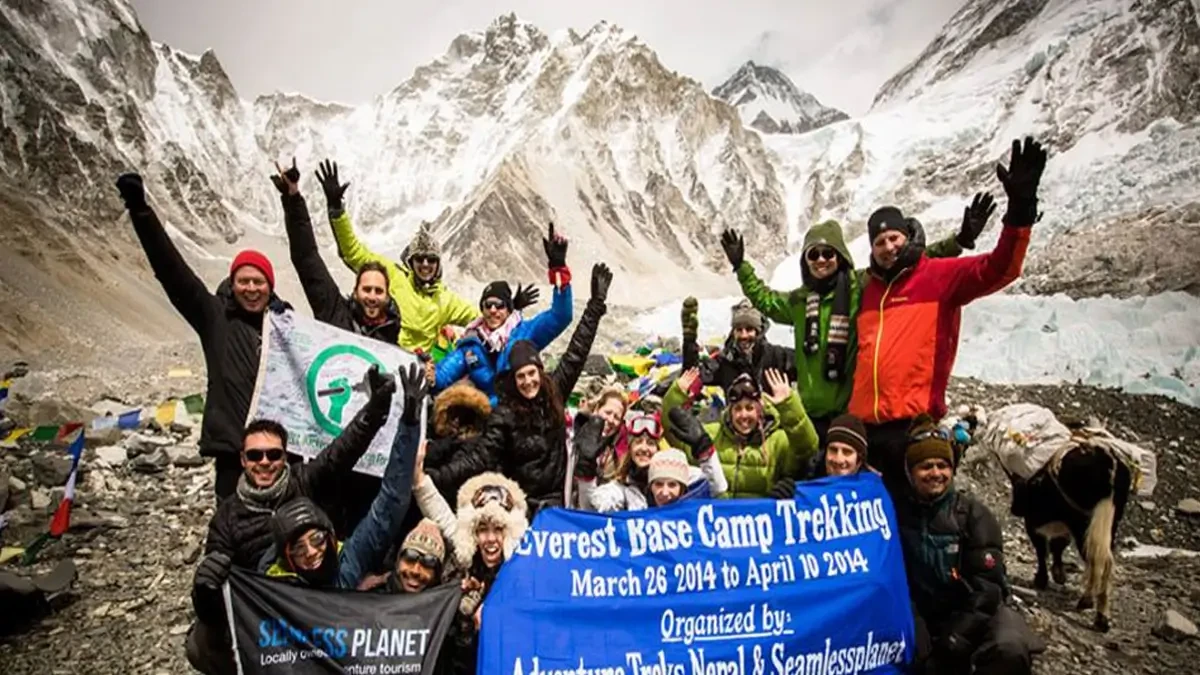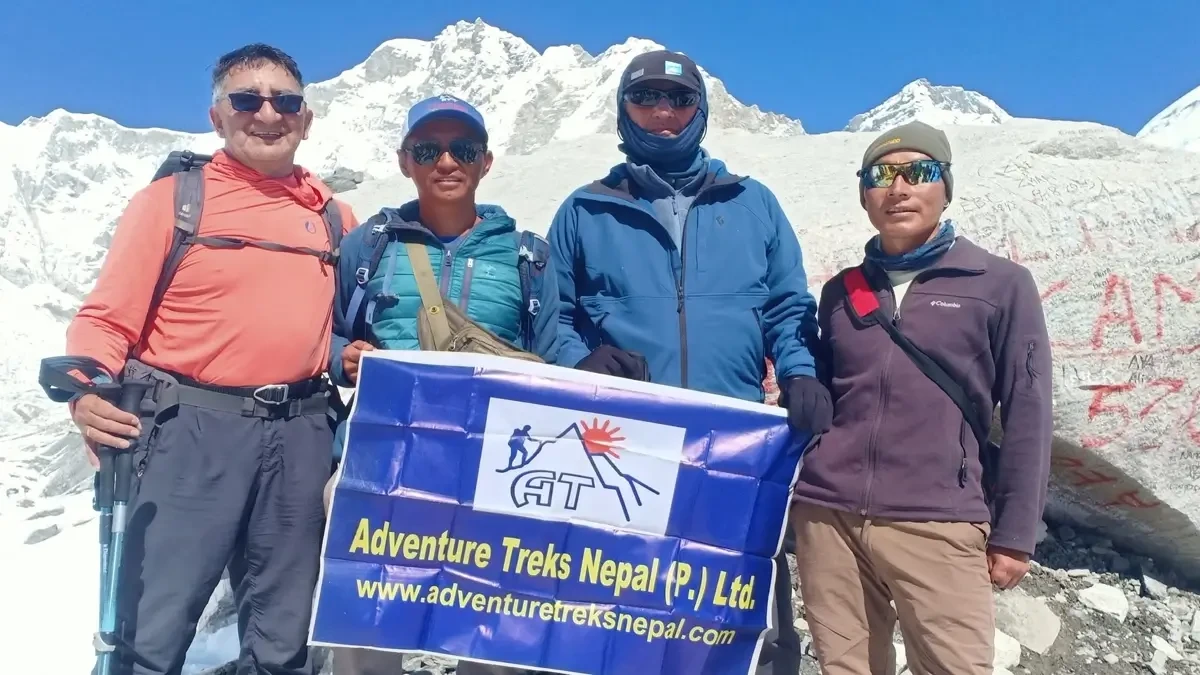Highlights
- Visit various historical places in the Capital city, such as Boudhanath, Soyambhunath, and Durbar Squares before exploring the Everest region.
- Enjoy an electrifying 4WD on a road alongside terraced fields, lush forests, mountain villages, and rivers to Kharikhola, an initial point of the trek.
- Discover Sherpa villages, such as Paiyun, Phakdin, Namche Bazaar, Debuche, Dingboche, and Lobuche while enjoying their warm hospitality.
- Enjoy breathtaking scenery from numerous vantage points, including Hotel Everest View(3880 m), Chhukung Valley(4730 m), Kalapatthar(5644 m), and Everest Base Camp(5364m).
- Sunrise view over the Himalayas like Mt. Everest, Nuptse, Lhotse, and AmaDablam will heal your body pains from Kalapatthar, the highest point in the trek.
The Everest Base Camp Trek Without Lukla Flight is a rewarding journey in the Everest region, where the UNESCO World Natural Heritage site, Sagarmatha National Park, and Mt. Everest(8848 m), the highest mountain on our planet, enhance the charm of its trekking areas and trails. Most adventurers in the universe choose to fly to Lukla, the gateway to the Everest trekking route, landing at Tenzing-Hillary Airport.
However, some select an exhilarating road ride alongside traditional villages, dense jungles, hills, and rivers before venturing into the exploration of Khumbu’s wilderness. Avoiding the possibility of flight cancellation due to rapidly changing weather, taking the route via Kharikhola and Paiyun may ensure that the package is activated on the exact departure date, depending on the Everest Base Camp Trek Without Flight Itinerary.
Because of such benefits and broader areas to discover in the territory, most trekkers prefer this itinerary. Accordingly, this 19-day package offers to reach the foothills of Everest at an elevation of 5364 m, following the footprints of legendary mountaineers such as Sir Edmund Hillary and Tenzing Norgay Sherpa without flights but walking on paths alongside the classic trail to Everest Base Camp (EBC).
Why does the Everest Base Camp Trek Without Lukla Flight stand out?
The Everest Base Camp Trek Without Lukla flight takes you through trails adorned with rhododendron forests, centuries-old monasteries, and villages of Shepas, where several mountain climbers spent the period during the training to reach the summit of Mt. Everest (8848 m). Breathtaking scenery and serene environs of both lower and higher elevations encourage you to capture their beauty in your camera roll, making you forget all efforts for covering the daily hiking distance.
While the flight to Lukla takes you directly to an elevation of 2800 m, the itinerary for 2026 without an airplane allows you to acclimatize naturally with gradual ascents. Unique Himalayan cultures of Everest captivate you when you see numerous historical gompas, chortens, and mani walls. Observing the activities of monks and nuns, you might get an opportunity to take part in morning prayers and other religious rituals, influenced by Tibetan Buddhism.
Namche Bazaar, often known as a Sherpa town, is a busy settlement where you can not only buy missing essentials but also have deep insight into the locals’ cultures and know about the bravery of Sherpas as they guide mountaineers to climb Everest. The major highlight, along with spending a worthwhile period at EBC, is also the breathtaking sunrise view over towering, snow-clad mountains such as Mt. Everest, Lobuche, Lhotse, Nuptse, Ama Dablam, and others from the Kalapatthar (5644), the highest vantage point of the Everest Base Camp Trek Without Lukla Flight 2026.
Can you spot rare animals during the Everest Base Camp Trek without Lukla flight?
Yes, there is a chance of witnessing rare animals while traversing through the sections of Sagarmatha National Park, depending on the Everest Base Camp Trek without flight. Wildlife and vegetation especially flourish in the pleasant weather of Spring and autumn, offering you their captivating activities in their own habitat. During walks between Phakding and Namche Bazaar, Himalayan Tahr, musk deer, red pandas, and langur monkeys are commonly visible, of which you can take beautiful pictures. Meanwhile, spot the Himalayan Pika, snow leopard, yak, Himalayan marmot, and blue sheep in higher mountainous landscapes.
Those who have an interest in birding might get a golden opportunity to capture pictures of the Himalayan Monal, Kalij Pheasant, snow pigeon, blood pheasant, Himalayan chough, and Himalayan Bulbul. However, starting the journey early morning, along with binoculars, is an ideal idea to enjoy watching them. Show your responsibility on the trek by not harming any wild animals and keeping distances, as well as not destroying vegetation like rhododendrons, birches, oaks, and other alpine plants, and considering your safety and sustainability.
Does Skipping the Lukla Flight Affect the Experience on the EBC route?
No, the experience in the Everest region, bypassing the Lukla flight, remains the same, as the route takes you through the same villages, such as Dingboche, Lobuche, and Gorakshep. No key highlights of the Everest Base Camp route are missed while choosing the itinerary of 2026/2027. Even though you miss aerial views from an airplane, rewards before joining the main trail will stir your feelings.
Once you reach Everest Base Camp at 5364 m and Kalapatthar at 5644 m, 360-degree panoramic vistas of mountain giants give you equal fulfillment. Before the busier trails of the trek, you will get a chance to immerse yourself in a more peaceful environment.
Is the 19 days Everest Base Camp Trek without Lukla flight for beginners?
Yes, the trekking to Everest Base Camp is also appropriate for novice trekkers with a sound body and a positive mindset. Although the trek does not include technical ascents and descents, we suggest getting involved in exercises one or two months before beginning walks in Everest’s terrain, including rugged landmarks, glacial moraines, and some risk zones, such as landslide-prone areas.
When an experienced Nepal trekking guide accompanies you throughout the journey, helping you navigate difficult sections, either seasoned or beginner hikers can complete a dream trek. However, symptoms of high acute sickness occur after 2500 m above sea level because of lower oxygen levels. Therefore, precaution together with gradual climbing to higher elevations is essential.
What is the total Cost of the Everest Base Camp Trek without Lukla flight?
Generally, the cost of any trek, including this 19 days Everest trek without the Lukla flight, depends on several factors, such as the travel company you choose (international, national, or local), the selected season to trek, the level of services (accommodation, meals, internet), the support staff (guide or porter), the group size, the itinerary, the duration, and the total trekking distance. Sometimes, unexpected expenses also occur during the trek for must-do things.
However, you can get an approximate idea of the Everest Base Camp Trek without Lukla Flight cost by referring to the included and excluded expenses listed in the Cost Details section. While selecting international agencies might be pricier, local companies also provide wonderful services at affordable prices without compromising the hiking experience. Trekking to Everest Base Camp in the off-season (monsoon and winter) is more affordable than in peak seasons due to fewer demands for meals and food and trekking permits.
Additionally, hiring a guide and porter as a group can lower the overall cost, as the expense is shared among all members. Compared to the Everest packages by airplane, this journey’s cost is cost-effective, as the cost for a 4WD is much lower than the airfare. Choose a similar itinerary without the Lukla flight, the classic route, or the Jiri to Everest Base Camp trek—24 days, if you have more days for your vacation. However, the cost may be higher due to the extended duration.
Is the 19 days Everest Base Camp Trek without Lukla flight itinerary the best?
When the package gets activated as you land in Kathmandu, our responsibility is to satisfy your desires and follow the Everest Base Camp Trek without Lukla flight itinerary for a smooth journey. Within almost 3 weeks, you have enough time to enjoy your vacation: 3 days in the Kathmandu valley with the rest of the time (before and after the trek), 2 days of travel by bus, and trekking of 13 days with our team. After preparing yourself fully while in Kathmandu for a day with the help of your guide and the company’s members, head to Kharikhola, the initial point of the trek.
Before reaching Namche Bazar, traverse through quaint villages such as Phakding and Paiyun with glimpses of locals’ activities and beautiful scenes. At Namche Bazar, you will meet climbers and trekkers, as it is a main hub before climbing up hills with little plants and more rugged lands. As for the Hotel Everest View the best spot for the Everest view is just 3 to 4 kilometers from Namche Bazar. From here, you will see close vistas of Mt. Everest, Lhotse, and other ranges.
Therefore, you will hike up to an elevation of 3833 m and return to the teahouse for lunch and then make your way towards Kyanjuma, located to the northeast of Namche Bazaar, taking 2 to 3 hours to reach. The next morning, proceed up to Devoche via Tengboche, observing a large monastery, yaks, and mind-blowing scenes. Waking up with the sunrise, get ready to push yourself up towards Dingboche, a settlement with fewer plants, Himalayan scenery, rocky terrain, and views of rivers, following the base of the village.
Since the trails are more challenging ahead, you will rest a day in Dingboche (4350 m) and go on a Side hike to Chhukung Valley. With more steep ascents, enjoying awe-inspiring views, reach Lobuche (4930 m), a beautiful village, where you will see simple houses made of stones and provide comfortable rooms and healthy foods. Covering 4.3 kilometers, reach Gorakshep, the last settlement before the Everest Base Camp, enjoying close views of Mountain ranges.
Depending on the Everest Base Camp Trek Without Lukla Flight itinerary, you will finally stand at 5364 m above sea level on 12th day of the trek feeling like having a great achievement after some hard ascents via rough landmarks. The next most anticipated destination is Kalapatthar for glorious sunrise view, which creates a dramatic enviroment for wonderful photography. Afterward, using the same way you used before to head towards Everest Base Camp, traverse quaint villages such as, Shomare, Pangboche, Debuche, Namchebazaar, and Lukla before reaching Khari Khola.
From which point you start the trek, you will end official trekking in the Everest region at the same place. The next day, drive towards Kathmandu to rest for a day before leaving the city for your homeland. This 19 days itinerary will not let you suffer through much physical and mental strains as it allows you to walk, acclimatizing your body in a natural way with gradual ascents and descents. The trekking distance and duration per day are also moderate due to difficulty level of the trek. However, our itinerary for this Everest trekking as customizable and you can customize it as your preferences. Accordingly, do not feel hesitation to present your thought infront of us to make it credible for a lifetime.
Why Adventure Treks Nepal for the Everest Base Camp Trek without Lukla flight?
Among several trekking companies in Nepal, Adventure Treks Nepal has also become reliable based on adventurers’ reviews. Our team is available 24 hours for your service, making it easier for you to plan for trips in various countries such as Nepal, Tibet, and Bhutan. Since we secure your safety throughout the journey, you can book the Everest Base Camp Trek Without Lukla Flight 19 Days, making it a smoother and worry-free trip than ever before. Our experienced guide and a porter enhance your trekking, managing all trekking logistics. Hence, choose us for a unique experience with perfect guidance and arrangement.









